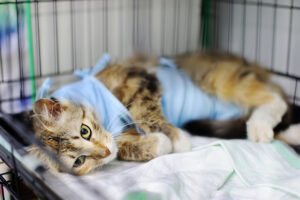
Knowing how to tell when your cat is in pain can help you notice problems earlier, and get your furry friend help before it worsens.
Cats are notorious for hiding pain, which can make it difficult to tell when they’re experiencing an illness or other serious physical issue. As responsible cat owners, it’s our duty to ensure our feline friends are comfortable and pain-free. Understanding the subtle signs of pain in cats is crucial, as early detection can lead to timely treatment and a better quality of life for your furry companion.
Changes in Behavior
One of the primary indicators that your cat may be in pain is a noticeable change in behavior. Cats are creatures of habit, so any deviation from their usual routine can be a red flag. Look out for the following behavioral changes:
- Aggression: If your normally friendly cat becomes aggressive, it could be due to pain. Cats in pain may lash out when touched or approached.
- Withdrawal: Cats may isolate themselves when in pain. If your usually social cat suddenly hides or avoids interaction, it’s a cause for concern.
- Restlessness: On the flip side, some cats become restless and unable to settle when they are hurting. They may pace, excessively groom themselves, or vocalize more than usual.
Changes in Appetite
Cats are notorious for being picky eaters, but a sudden loss of appetite or a significant decrease in food intake can signal discomfort. Conversely, some cats may eat less but still gain weight due to reduced activity levels.
Altered Grooming Habits
Cats are meticulous groomers, and changes in grooming behavior can indicate pain. Cats may either groom excessively or neglect their grooming altogether. Look for mats, unkempt fur, or areas of the body your cat avoids grooming.
Changes in Posture and Mobility
Pain can affect a cat’s posture and mobility. Watch for the following signs:
- Limping: Observe how your cat moves. If they are limping or favoring a particular leg, it could indicate pain or injury.
- Hunched Posture: Cats in pain often assume a hunched or tense posture, trying to protect the affected area.
- Reluctance to Jump: If your cat usually loves to jump but suddenly avoids it, it could be because of pain.
Vocalizations
While some cats become more vocal when in pain, others become unusually quiet. Pay attention to any new or unusual vocalizations, such as crying, yowling, or growling.
Changes in Litter Box Behavior
A cat’s litter box habits can provide valuable insights into their health. Look for the following changes:
- Urination or Defecation Outside the Box: Cats may avoid the litter box if they associate it with pain.
- Straining: Straining to urinate or defecate can be a sign of discomfort, especially in cases of urinary tract issues or constipation.
Respiratory Changes
Pain can affect a cat’s breathing. Labored or rapid breathing, as well as shallow breaths, can be indicative of discomfort.
Physical Signs
In some cases, you may be able to spot physical signs of pain, such as swelling, wounds, or visible injuries. Be sure to check your cat regularly for any abnormalities. This is easier with cats that enjoy being pet or handled by their owners, but more independent kitties may need extra coaxing for owners to have an opportunity to look them over.
Trust Maryland Veterinary Surgical Services With Your Companion’s Health
Your companion’s health is important, and the team at MVSS is ready to provide the best care possible for your furry family. We are dedicated to combining comprehensive exams and assessments with informative and honest discussions of your companion’s care. Once we have worked with you to decide on the best course of action for your dog, our professionals will use their surgical expertise to work towards the goal of giving your companion an active and pain-free life. We are proud to serve loyal companions in Catonsville and Baltimore. To learn more about our services, give us a call at 410-788-4088 or visit us online. For more information and tips for pet health, follow us on Facebook and Pinterest.
